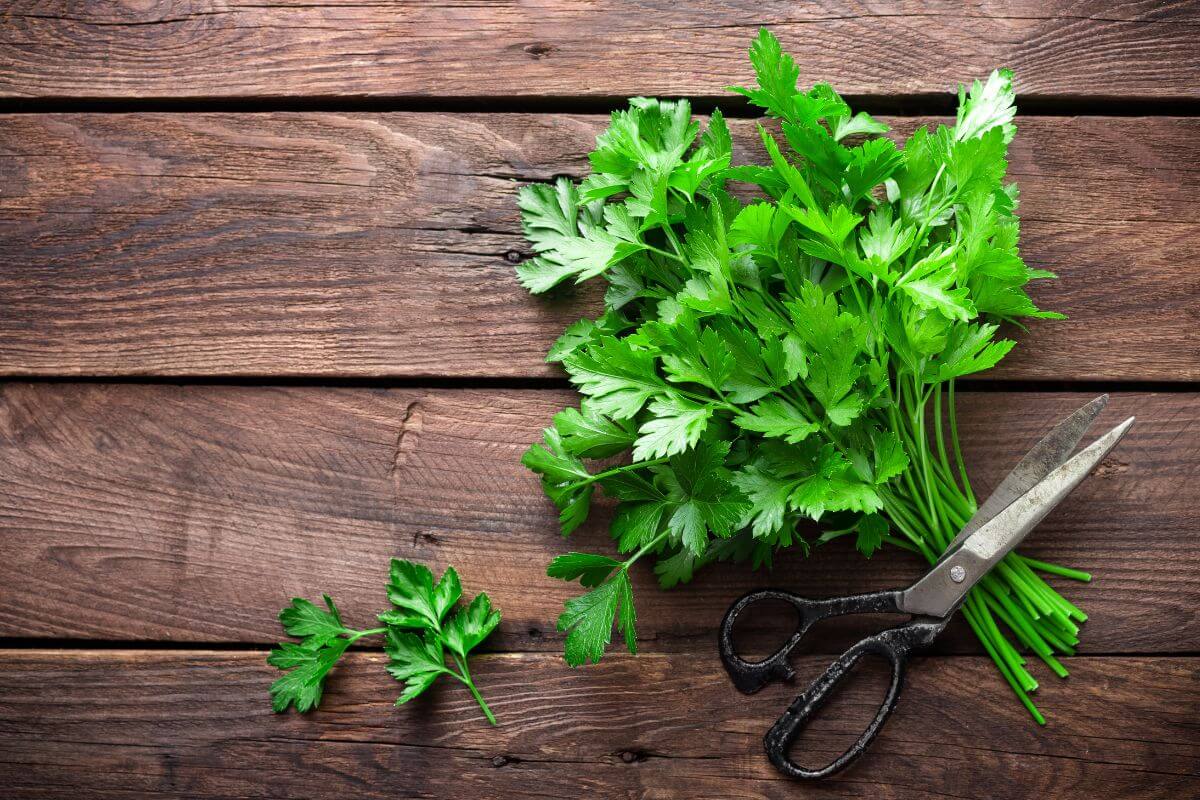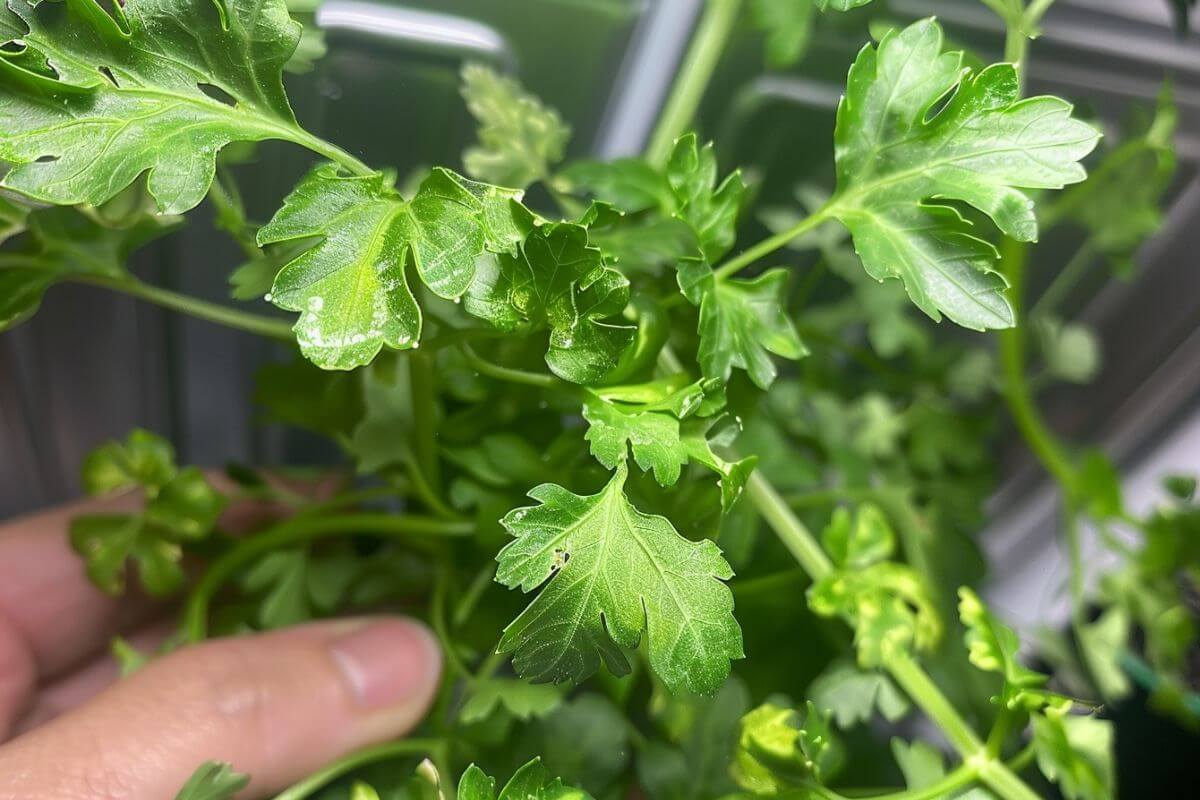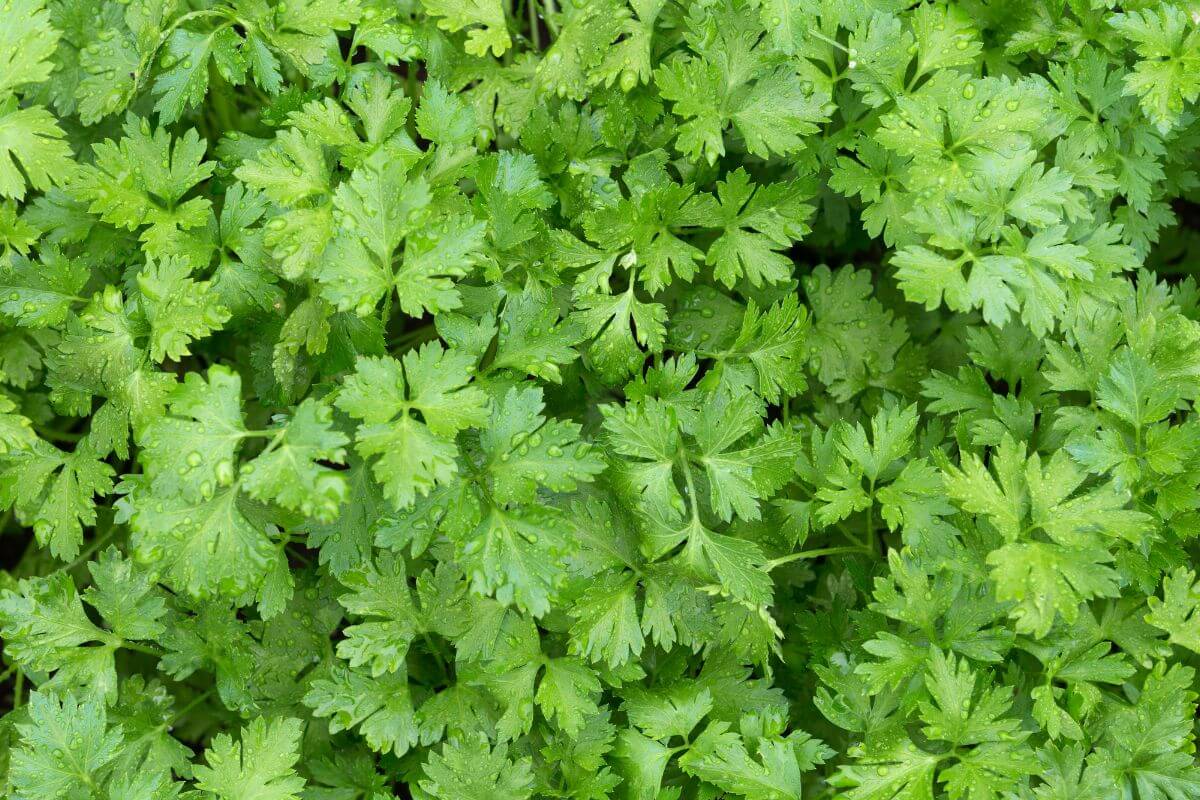Let’s dive into the world of parsley pruning. This green gem is packed with vitamins A and C, plus calcium and potassium. Talk about a nutritional powerhouse!
Pruning your AeroGarden parsley is the key to unlocking vigorous growth and a bountiful harvest. Whether you’re a green thumb or a newbie, you’ll soon be snipping like a pro.
Ever wondered why restaurant dishes always look so fancy with that perfect parsley garnish? Now you can recreate that at home! With the right pruning techniques, you’ll have an endless supply of fresh, flavorful parsley at your fingertips.
Ready to take your culinary game up a notch? Stick around as I talk about the secrets to AeroGarden parsley perfection.
- Related article: What Are the Best Crops to Grow in an AeroGarden
7 Key Takeaways on Pruning Parsley in AeroGarden
- Pruning is like giving your plants a haircut. It stimulates new growth and keeps them healthy.
- Trim parsley early in its growth to encourage bushy, flavorful leaves rather than letting it bolt to seed.
- Don’t shy away from frequent trimming to maintain a steady supply of fresh parsley for your cooking needs.
- Before winter sets in, give your parsley a thorough pruning to prepare it for colder temperatures.
- Use clean tools and start with outer leaves when pruning parsley in your AeroGarden to promote continued growth.
- Pruning not only keeps your parsley tidy but also enhances air circulation, reduces pests, and prevents diseases.
- By trimming parsley regularly, you preserve its sweet flavor and ensure a bountiful harvest for culinary delights.
What Is Pruning?

What exactly is pruning? Let’s dive into this essential gardening skill that’ll have your greenery thriving in no time. Pruning isn’t just about snipping away willy-nilly. It’s an art form that helps your plants grow stronger and look their best.
Pruning is like giving your plants a haircut. You’re carefully removing certain parts to help them thrive. Why bother? Well, it’s not just about making your garden look pretty.
But before you start chopping away, remember that pruning is an art. You need to know what you’re doing. If you’re not careful, you could hurt your plants instead of helping them. Start small and learn as you go. Soon enough, you will find pruning to be a relaxing way to spend time in your garden.
By mastering this technique, you’ll transform your space into a green paradise. Every snip is an opportunity for new growth. So grab those shears and let’s turn your garden into a showstopper!
When Should You Prune Your Parsley?

Parsley is technically a biennial plant. This means it lives for two years. In the first year, it grows leaves. In the second year, it flowers and produces seeds. But most gardeners treat it as an annual. This is because it is frequently harvested for its leaves before it reaches the flowering stage.
You’ll want to keep your parsley in top shape for the best flavor. Let’s talk about when to trim it.
- Early Growth – Watch out for three leaf segments. That’s your cue to give it a haircut. This helps your parsley grow bushy instead of lanky.
- Before It Bolts – Keep an eye out for flowers. As soon as you spot them, grab your scissors. Why? Flowers lead to seeds. Seeds mean your parsley’s flavor is on its way out.
- For Maintenance – Don’t be afraid to trim often. More cuts mean more leaves for your cooking. But don’t go overboard. Your plant needs some leaves to make food and grow back.
- Before Winter – When Jack Frost is about to come, give your parsley a more severe haircut. This prep work helps the plant hunker down for the cold that is about to come.
- When It Reaches a Certain Height – When your parsley reaches about 6 to 8 inches tall, it’s showtime! This height usually means your plant is ready for a trim. Don’t wait too long, or you’ll end up with a leggy, sad-looking herb.
I’ve found that regular trimming keeps my parsley thriving all season. It’s like a little garden spa day for your herbs. Plus, you’ll always have fresh parsley on hand for that perfect garnish or homemade pesto. How’s that for a win-win?
How Do You Prune Parsley in the AeroGarden?
Now that we have identified the right times to prune parsley, let’s get into the details of how to do it.
Here’s a step-by-step list to help you prune that parsley like a pro:
- Grab clean scissors or pruning shears. Cleaning your tools beforehand will ensure that bacteria or diseases are not transferred from one plant to another.
- Always start with the outer leaves first. This strategy lets the inner leaves keep growing, ensuring you’ve always got fresh parsley on hand.
- Cut stems just above a set of leaves.
- Avoid getting too close to the plant’s crown.
- If you spot any flower stalks, snip ’em off right away. Flowering means your plant’s thinking about bolting and bolting changes your herb’s flavor.
- Never trim more than one-third of your plant.
Remember that the goal is to promote leaf growth without stressing the entire plant. It’s like giving your parsley a little haircut to keep it looking fresh.
I’ve found that regular pruning every 1-2 weeks works wonders. It keeps your AeroGarden parsley compact and productive. Plus, you’ll have a steady supply of fresh herbs for your cooking adventures.
Why Should You Prune Parsley?

The pruning process is more than just keeping things tidy. It has several benefits for your indoor herb garden.
Here’s why pruning your parsley is so important:
- Keeps Your Plant Tidy – When there are no excess branches or leaves, you have a more neat space.
- Shapes Plant to Fit Your Garden – This is particularly important for parsley grown in the AeroGarden due to limited space to grow. Once those leaves touch the Grow Light, they could potentially burn!
- Allows Airflow – Indoor gardens still need good air circulation.
- Encourages New Growth – When you snip off those older stems, you’re telling your parsley to grow more leaves. Your plants will stay bushy and full instead of tall and leggy.
- Prevents Overcrowding – Pruning gives each plant its own space to thrive. No more fighting for light or nutrients.
- Stops Flowering – Ever seen little flower buds on your parsley? Snip those off right away. They’ll steal energy from leaf production if you let them grow.
- Reduces Pest Problems – Pests love hiding in overgrown plants. Keep things trimmed and you’ll make it harder for those little buggers to set up shop.
- Increases Your Harvest – Pruning your parsley helps keep it healthy and encourages new leaf production. For it to continue growing, it needs to be pruned so that new shoots develop.
- Prevents Fungal Issues – If the parsley gets too crowded, there’s not enough air circulation for moisture to evaporate from within the plants. In moist environments like these, fungus grows easily and quickly.
- Enhances Flavor – Pruned parsley keeps its sweet flavor longer.
There are so many benefits to pruning parsley so don’t hesitate to grab those scissors and give your herb a little haircut.
How to Prune Parsley in AeroGarden Final Thoughts
Pruning isn’t just about cutting back tall plants. It’s an art that can make your garden thrive. When you prune, you’re giving your plants a chance to grow stronger and look better. But don’t worry if you’re new to this. You can start small and learn as you go.
Think of proper pruning as a way to shape your garden’s future. Remember to pay attention to how your plants respond after each pruning session. Some might need more frequent trimming, while others do fine with less. It’s all about finding what works best for your green friends.
Pruning isn’t just for outdoor plants. If you have an AeroGarden or grow herbs indoors, you can use these skills too. Parsley particularly loves a good trim now and then. It’ll grow back bushier and tastier.
So grab your pruning shears and give it a try. You might be surprised at how much you enjoy this part of gardening. It’s a great way to connect with your plants and watch them flourish.
How to Prune Parsley in AeroGarden FAQs
1. When to First Trim Parsley?
When your parsley plant shows off three segments of true leaves, it’s time for its first haircut. This early trim encourages your plant to grow bushier and fuller. Keep an eye out for those tiny flower buds. As soon as you spot them, snip them. Flowering signals the plant’s attempt to produce seeds. Trimming at this stage preserves the plant’s energy for leaf production and keeps your parsley tasty and aromatic.
2. How Long Do Herbs Last in AeroGarden?
Growing herbs is a rewarding experience. AeroGarden lets you enjoy harvests for about 3-4 months with most herbs. Regular pruning and harvesting will encourage new growth so don’t hesitate to pinch off any flowers that appear at the leaf joints. This trick will keep your plant focused on producing those tasty leaves instead of going to seed.
3. How Do You Keep Parsley From Getting Leggy?
Parsley grows fast, so you’ll need to stay on top of it. Give it a little pinch now and then to stop it from getting too big and leggy. If your parsley looks like it’s past its prime, don’t hesitate to pull it out. Plant a new one in its place instead. This way, you’ll always have young, tender leaves for your dishes.
4. How Do You Prune Hydroponic Parsley?
Snip your parsley plant with care using sharp scissors. Cut about a third from the top. This part’s perfect for cooking. Leave the rest of the plant to grow new leaves. Once it’s thriving, you can harvest weekly.
Here are other AeroGarden care and grow guides for other plants:
- Cultivating Tomatoes in AeroGarden
- Lettuce Yield in AeroGarden
- Why Is My AeroGarden Lettuce Bitter?
- AeroGarden Basil Planting
Sources:
- https://blogs.ifas.ufl.edu/pascoco/2024/03/26/spice-up-your-life-a-beginners-guide-to-growing-parsley/
- https://plantvillage.psu.edu/posts/4880-general-which-vegetables-and-herbs-do-well-in-hydroponics
- https://www.purdue.edu/hla/sites/master-gardener/wp-content/uploads/sites/9/2022/10/Pages-from-Hydroponics-for-the-Home-Grower-Howard-M-Resh.pdf

